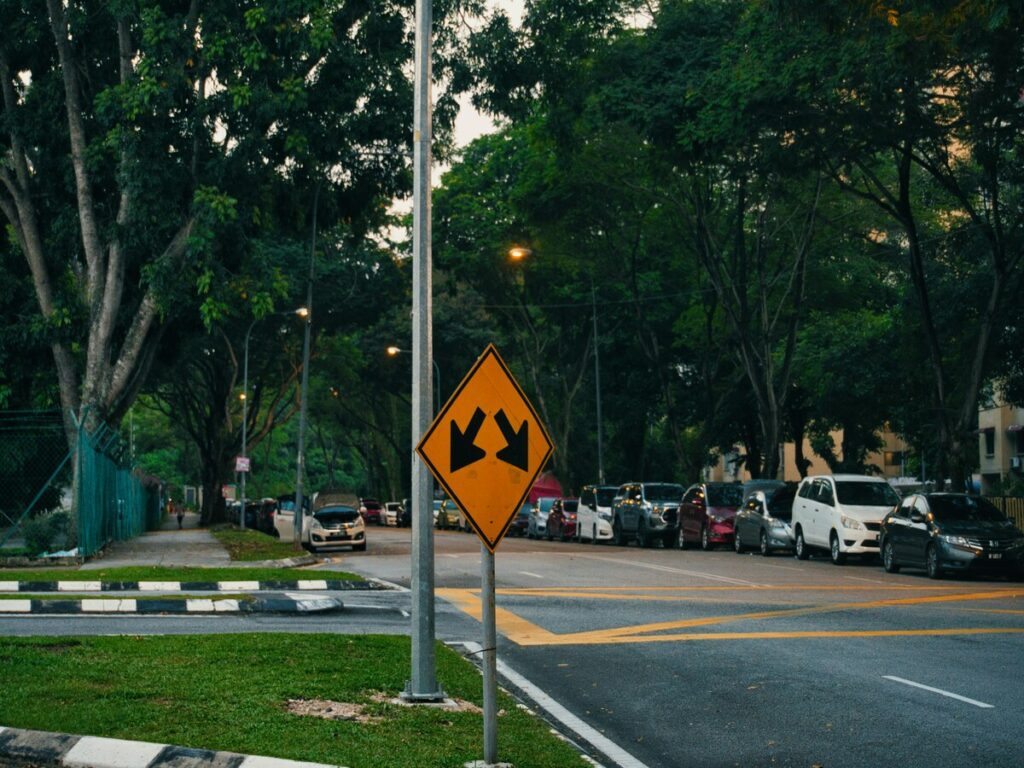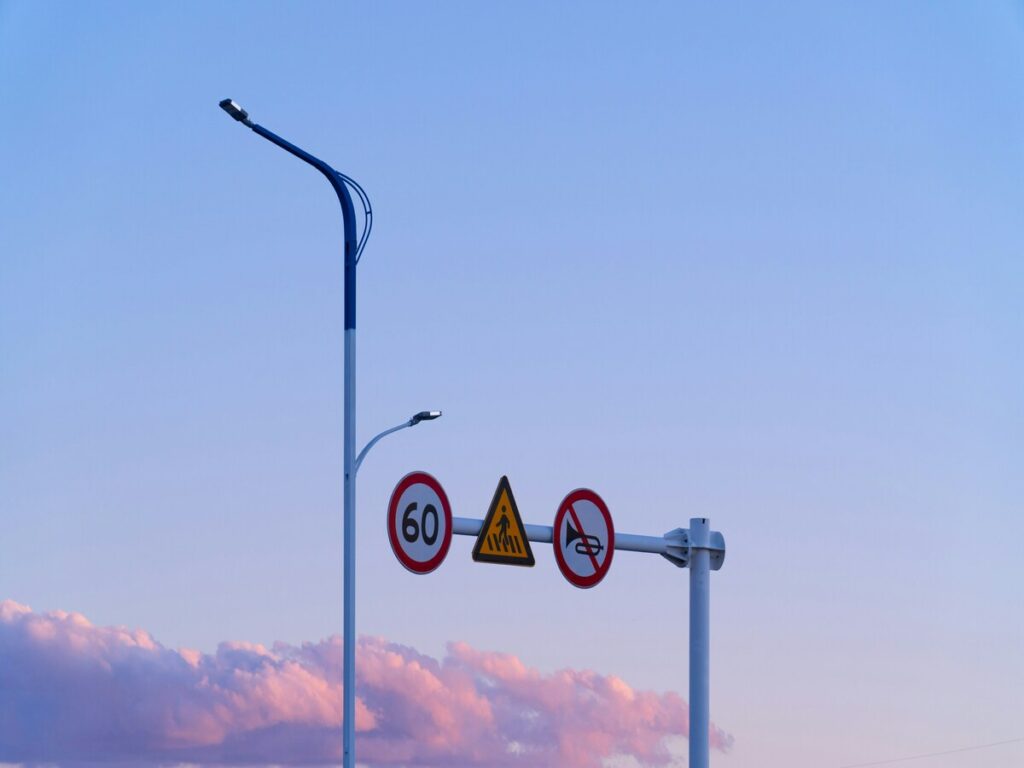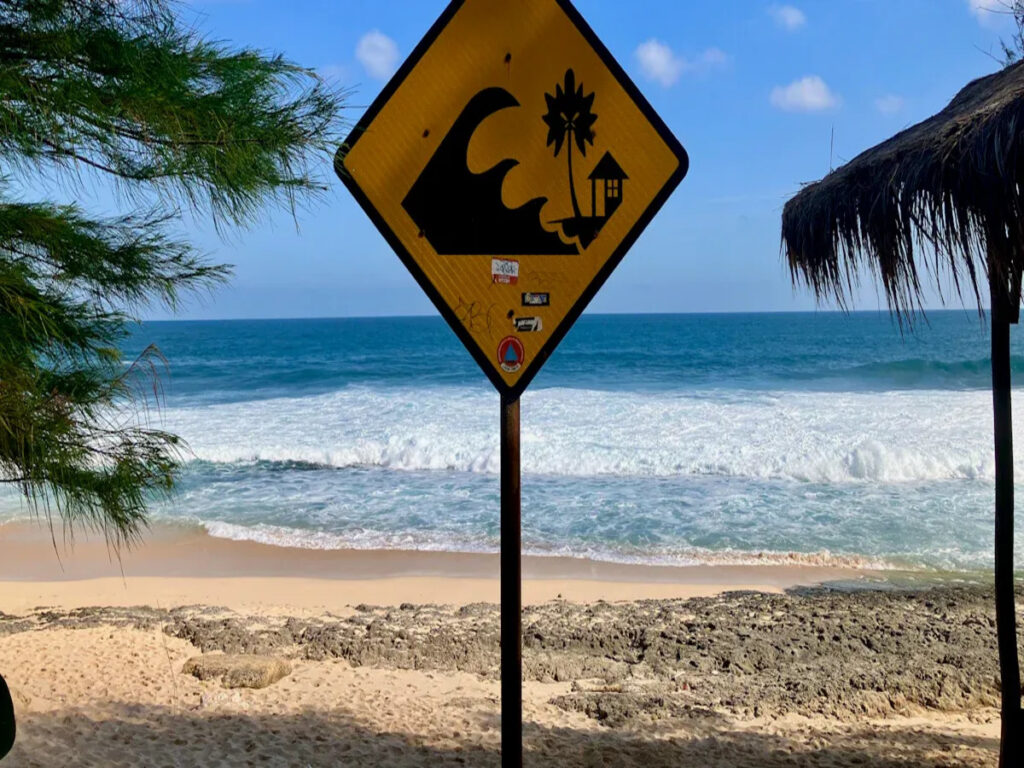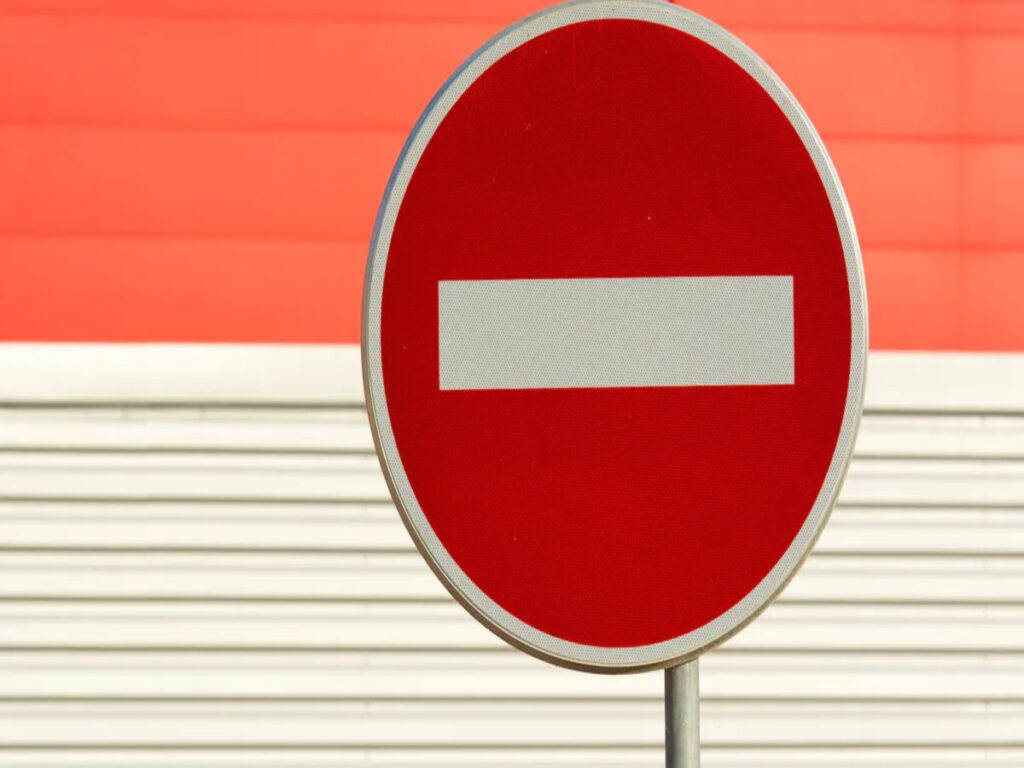
Australian road signs help keep roads safe and easy to use. Old road signs can confuse drivers and cause mistakes. Pelo menos 55% of drivers run flashing red lights when signs are not clear. Better sign placement helps more people see them. Detection rates go up from 69.47% para 87.18%. These numbers show that clear signs are very important for road safety.
| Statistic Description | Numerical Value / Percentage |
|---|---|
| Percentage of drivers running flashing red lights | Pelo menos 55% |
| Detection rate of first warning sign (baseline) | 69.47% no 104.96 m before stop line |
| Detection rate of first warning sign (improved placement) | 76.28% no 266.06 m before stop line |
| Detection rate of Flashing-light Ahead sign (improved) | 87.18% |
| Effect of foggy conditions on brake response and detection | Increased brake response time, reduced detection |
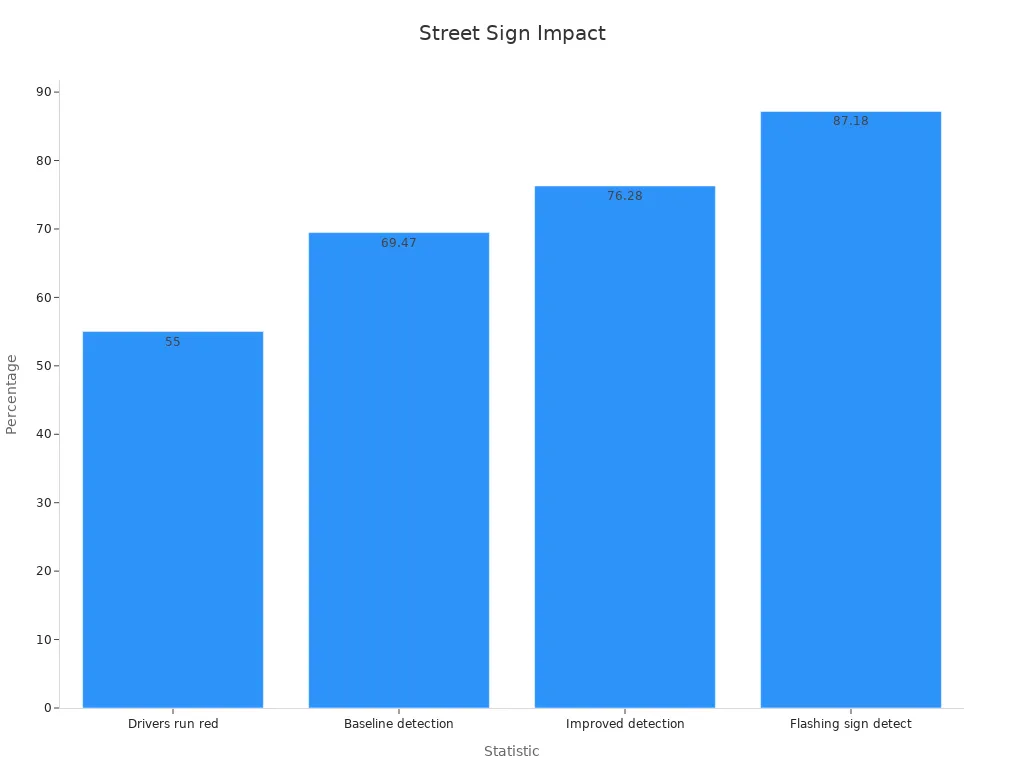
Urban planners, designers, traffic planners, and road safety experts use modern Australian road signs. Esses traffic safety signs help stop accidents and make roads safer for everyone.
Takeaways -chave
- Old Australian road signs were not easy to read or see. This made people confused and caused accidents. Modern signs use bright colours and clear symbols. They also use better materials. This helps people see them better and keeps roads safer. Standardised signs are now used in every state. This helps drivers know the rules and find their way easily. New signs use simple pictures instead of words. This helps all drivers, like tourists and older people. Updating signs lowers the number of crashes. It makes roads safer for everyone.
Reasons for Change
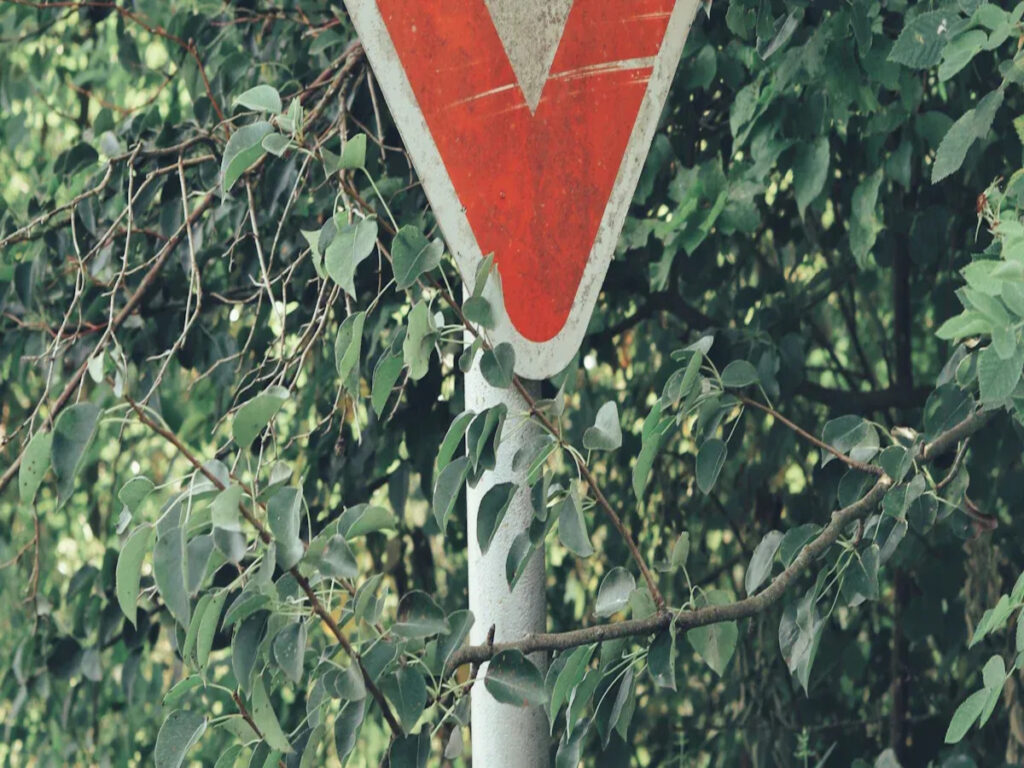
Design Issues
Old road safety signs had shapes that were hard to figure out. They also used fonts that were not easy to read. Some signs had too much information on them. Others used colours that did not stand out well. Drivers could not understand these signs quickly. This was even harder when cars moved fast. Simple shapes and clear fonts help people read signs faster. Modern signs use bold letters and bright colours. This makes the message easy to see. These changes help everyone, young and old, follow road rules without getting mixed up.
Visibility Problems
Many old signs faded and lost their shine over time. They were hard to see at night or in bad weather. Old signs without reflectors are 10 para 20 percent less clear than new ones. Older drivers have more trouble seeing these signs. They need bigger letters and brighter colours to read from far away. New signs use fluorescent sheeting to help people see them better, especially at dusk. Por exemplo, fluorescent red signs are seen 90% of the time at 30 metres. Standard red signs are only seen 23% of the time. Modern signs are easier to see because they have better contrast. O Manual sobre Dispositivos Uniformes de Controle de Tráfego (MUTCD) says all signs must be retroreflective or lit up. This helps drivers see important messages day and night.
Observação: Modern reflective materials give more contrast and brightness. This helps older drivers and makes roads safer for everyone.
Modern Traffic Demands
Australia’s roads have changed a lot over time. There are more cars and bigger trucks now. Roads are also built in new ways. Old signs do not work well for today’s traffic. Drivers need clear and quick instructions to stay safe. New signs use simple pictures and fewer words. This helps drivers react faster. As traffic grows, clear signs are even more important. They help stop accidents and keep roads safe.
History of Australia Street Signs
Early Signage and Evolution
Australian road safety signs originally consisted of wooden boards and metal plates. These early signs only gave simple directions or warnings. Each town made its own signs, so they looked different everywhere. There were no clear rules for shapes, colours, or symbols. Drivers often did not know what the signs meant. Mais tarde, road authorities saw that better signs were needed. They wanted signs that everyone could recognise.
Impact of Metrication
In the 1970s, Australia changed from imperial to metric units. This change affected many things, including road signs. Speed limits and distances changed from miles to kilometres. Workers replaced thousands of signs all over the country. Metrication made signs more alike and easier to read. People could drive between states without getting confused. The change also helped Australia follow world standards.
Observação: Metrication made signs clearer for both locals and visitors. This helped keep everyone safer.
Move Towards Standardisation
After metrication, road authorities wanted one set of signs for all. They used ideas from other countries and new safety studies. The aim was to make signs easy to see and understand. Standardisation replaced the old mixed designs with clear rules. Agora, drivers see the same signs in every state and territory. This helps everyone follow the rules and stay safe.
Outdated Route Signs and Other Examples
Old Directional Signs
Many old route signs in Australia had tricky symbols and too much writing. Drivers found these signs hard to read quickly. This was even worse when cars moved fast. Some signs listed many places at once. This made it tough to know which way to go. Tourist signs sometimes used odd colours or different writing styles. This made things even more confusing. Tourist drive markers used to look different in each state. Agora, new route signs have clear arrows and simple place names. They also use the same colours everywhere. These changes help drivers choose the right way faster. Fewer mistakes happen on busy roads.
Obsolete Warning Signs
Old warning signs often did not use the same symbols. Some signs had words instead of pictures. This made drivers react slower. Some signs faded in the sun or rain. This made them hard to see. Drivers sometimes missed warnings about sharp bends or animal crossings. They also missed signs for roadworks. New warning signs use bright colours and shiny materials. Pictures like kangaroos or falling rocks are easy to spot. These changes help all drivers stay safe. Tourists who do not speak English well can also understand the signs.
Non-Standard Regulatory Signs
Non-standard regulatory signs used to be in many places. These signs did not match the national rules for size or colour. They were also not as shiny as they should be. Drivers found them hard to read at night or in bad weather. The table below shows how following the rules made signs safer:
| Compliance Aspect | Before Compliance (Non-Standard Signs) | After Compliance (Standard Signs) |
|---|---|---|
| Night-time Visibility | Signs were hard to see at night | Signs meet AS/NZS 1906.1 reflectivity standards, so they are easy to see at night and in bad weather |
| Message Clarity | Messages were crowded and confusing | Messages are clear, simple, and easy to understand |
| Durabilidade | Signs were weak and got damaged by weather | Signs are strong and last longer, Mesmo com mau tempo |
- Wrong-way crashes are much more dangerous than other crashes. Clear signs help stop these deadly mistakes.
- Studies show that simple, matching signs help people trust the signs. They also make things less confusing, especially for young or new drivers.
- Signs that look the same everywhere help tourists and new residents feel sure on the road.
Observação: Good signs help everyone drive safely and reach their destination without worry.
Modern Solutions

New Design Standards
Australian road signs now have strict design rules. Authorities use ISO 7010 and AS/NZS 1906 diretrizes. These rules say what shapes, colours, and symbols to use. Signs must be easy for everyone to see and understand. The new system helps drivers spot messages fast. All states use the same designs, so there is less confusion. People can drive anywhere and see the same signs. This makes roads safer for all road users.
Improved Materials
Modern road signs use better materials that last longer. Engineers pick cold plastic and special waterborne paints. These materials stay bright and shiny for many years. Por exemplo:
- Premium cold plastic keeps its shine for over two years. Standard materials often lose brightness before two years.
- High-performance waterborne paints last about two years. Solventborne paints lose quality in six months.
- European studies show premium materials make signs last longer. They also help signs stay bright and easy to see. This means fewer signs need replacing, so there is less waste and lower costs.
Strong materials help signs stay clear in all weather. Drivers can trust signs to guide them safely at any time.
Simplified Messaging
Modern signs use simple pictures and not many words. Designers pick symbols that everyone can understand. This helps drivers react quickly, even if they do not speak English. Clear symbols take the place of long sentences. Por exemplo, a kangaroo symbol warns about animals crossing. A curved arrow shows a sharp bend ahead. Simple messages make roads safer and help stop mistakes. Easy-to-read signs help all drivers, including tourists and new people.
Benefits of Updating
Segurança aprimorada
Modern Australian road signs help keep people safe. Bright colours and clear symbols make signs easy to see. Drivers can spot warnings and instructions very quickly. This helps them react faster and avoid accidents. New signs use materials that stay bright in rain or fog. They are also easy to see at night. Older drivers and people who do not speak English well can understand the signs. A tourist can see a kangaroo picture or a sharp bend symbol. They know what it means, even if they do not know the words. Signs that look the same everywhere help new drivers and visitors feel less worried.
Better Compliance
New road signs help people follow traffic rules better. When signs look the same in every place, drivers know what to do. O 2025 Traffic Management Code of Practice in Western Australia shows this works well:
- Updated Australian Standards (COMO 1743) tell how to design road signs.
- Standardised road-closure signs like ROAD CLOSED and FOOTPATH CLOSED are now needed.
- Clearer rules for where to put signs help workers set them up right.
- Stricter training and no more old exemptions mean everyone follows the same rules.
- These changes make roads safer and help make sure traffic laws are the same everywhere.
Consistent Navigation
Modern and matching road signs help drivers find their way. Signs that follow Austroads standards are easier to read and last longer. Bigger signs on highways help drivers see directions from far away. In remote places, solar-powered signs and real-time updates warn about bushfires or bad weather. These changes help locals and tourists travel safely. A tourist can drive across states and trust the signs will guide them, no matter where they go.
Australia stopped using old road signs to make roads safer. The new signs use stronger materials and clearer symbols. These changes help drivers see signs faster and make fewer mistakes. Studies show that brighter signs help stop night-time crashes and make roads safer:
- Night-time crashes dropped by 6% after using brighter road markings that last longer.
- Brighter signs mean fewer crashes, especially on roads without intersections.
- Special markings for wet weather help keep roads safe when it rains at night.
Keeping road signs updated and the same everywhere will help keep everyone safe.
Perguntas frequentes
What happens to old road signs after replacement?
Many councils recycle old signs. Some signs are used for training or art. Others are sent to metal recycling centres. This helps cut down on waste. It also supports the environment.
Why do new signs use more symbols than words?
Symbols help everyone understand signs quickly. People who speak other languages can recognise symbols. Drivers react faster to pictures than to long words. This makes roads safer for all.
How often do authorities update road signs in Australia?
Authorities check signs often. They replace signs that are damaged or faded. Big updates happen when rules or standards change. Some places review signs every few years.
Do new materials make signs last longer?
Sim. New materials like premium plastics and reflective coatings keep signs bright and strong. Signs stay easy to see in rain, névoa, and at night. This means fewer replacements and lower costs.
Are all Australian states using the same road sign standards now?
Most states follow national standards like AS/NZS 1906. This means signs look the same across Australia. Drivers can travel between states and see the same signs everywhere.


